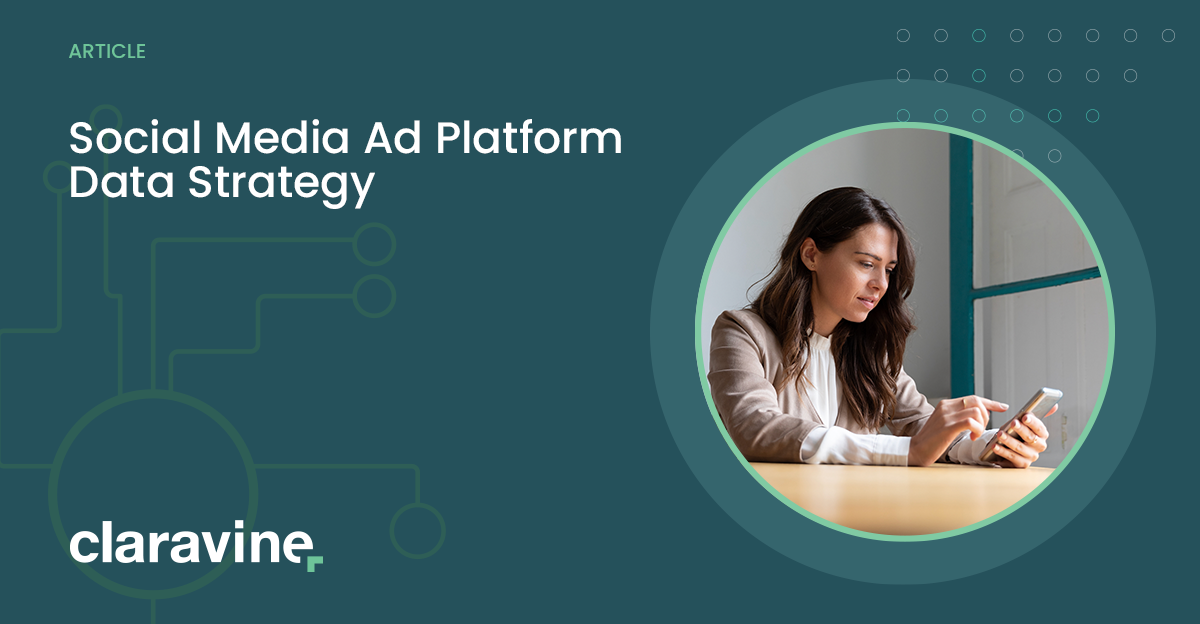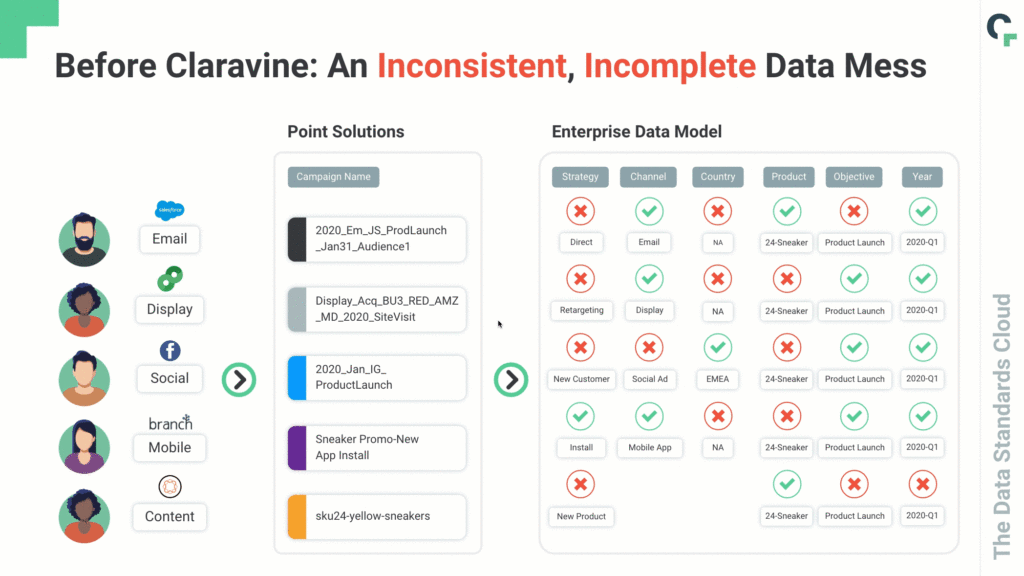Social Media Ad Platform Data Strategy

There are more social media platforms than ever to run advertising on (but apparently not MySpace as I didn’t see any ads when I went to do my research for this article). But even if MySpace is not even something you’ve heard of or want to remember, there are lots of new opportunities on the SnapChats, Instagrams and TikToks of the world.
And it’s not just these newer platforms you need to wrangle and master but the traditional players like YouTube, Facebook (excuse me, Meta), Twitter, LinkedIn and some others I don’t use but have huge audiences and advertising opportunities (I’m looking at you, Pinterest). And I think it’s worth mentioning that not all social media ad campaigns are run natively on platforms. Many companies and teams use third-party solutions like Mediaocean, Smartly, Skai, Marin and more to execute paid social.
You’ve also got all kinds of traditional and new ad types to run as well, from Collections to Stories, Catalogs to Videos and more. These ads are rich with digital and interactive media still driving traditional goals of brand awareness, conversions and sales. And for big brands, you usually have thousands or more campaigns, ad groups, and ads running simultaneously.
Not to forget that no one person or team is launching and managing all of these campaigns, assets, landing pages and everything else involved in digital ad trafficking and execution. Internal teams and agencies “work together” to turn ideas into experiences.
Yikes. It’s hard to fathom juggling coordination across tech, teams, campaigns, content/media to get just one consistent omni-channel campaign off the ground. Imagine the large-scale campaign execution required of those responsible for big brand advertising and the hundreds of thousands awareness, product, engagement and other campaigns they’ve come up with (did you know Mr. Peanut died in 2020 at the ripe age of 104 – I did not). Note that I didn’t even mention the personalization that is often strewn throughout. Strewn is probably a good word for the maturity of personalization by the way – it definitely has a ways to go.
What is the tie that binds people, tech, campaigns, personalization, and measurement together to make this all work as effectively as possible?
The data. And it’s not the end result performance data only, but the metadata that describes everything involved. Some examples:
- Campaign and ad group data has targeting details like ID, brand, audience, source/medium, platform, offer, region, run dates and the list goes on
- Content/Media has ID, title, theme, category, season, geo, visual description, emotion, associate campaign(s), characters and more
- Ad data has the combination of campaign and content along with ID, type, placement, product (or whatever is being promoted), offer, destination, conversion goal, etc.
For more metadata to consider, here’s a checklist (which, while longer, isn’t even comprehensive).
I also gave a little super power hint in the bullets above: an ID exists in each. I’ll get to that.
That’s a lot to manage – the coordination of everything including the data. Let’s focus on the data, though.
Naming is critical
Look back to that list of all of the metadata you need or want for each of those parts of social media advertising. How do you feasibly make sure that not only the information is present at all but consistent and standardized across every platform, campaign and ad? When the same campaign theme is being run across platforms, e.g. SnapChat, Instagram and TikTok, wouldn’t you want to be able to join as many details as possible into how you measure performance? Yes, there is some uniqueness to each platform but there are many more similarities to evaluate. If each platform is promoting the same product – connecting the campaigns, content/media used and ads run is essential.
Many people reading this know you’re spending millions of dollars regularly on cross-platform campaigns. Being able to measure individual platform performance is table stakes. Taking the combined campaign effort is a step above. Sharing learnings and optimization opportunities that take from one channel to another is next level. And findings like those discovered in the full cross-platform campaign that are then applied to future campaigns is transformative.
Let’s just consider the basics and you’ll still see the power of connecting this data. Take the campaign name alone.
Like I said before, you have a number of places where you’re running social media ads (we’re not even considering other channels outside of social media in this example either). You have all of the social media platforms themselves along with the tools your teams or agencies might use to manage large scale execution.
How is everyone aligning on what specifically to name the campaign so it’s exact? At best, a shared spreadsheet or homegrown solution that has missing governance and lack of real-time information. We see it all too often – there’s no mechanism to make sure the right name is actually being used, whether they knew what the right name was or not.

Why is being exact so important? This data flows downstream to your analytics and measurement teams. When it’s inconsistent, it requires unnecessary clean up time – time wasted instead of being focused on the high value analysis activities. When it’s exact it is easy to connect metadata together using these data “keys” – insights go from days or weeks to minutes with richer detail and broader views across campaign efforts. True story.

Awesome – now you have a glimpse into the importance of standardized names in just one spot, the campaign name. That alone bridges a long-standing gap in better analysis. As we’re all too accustomed to hearing, “but wait, there’s more”.
What’s the “more”?
First, I’m going to state the obvious. This information is being shared to not only help you but to tell you that our platform does this job very well across all of that wonderful metadata you need. And it does it even better of late with existing and newer ad platform integrations we’ve released. That’s all I’ll pitch about us here though – you are free to take a peek at those pages and reach out.
Expanding on the campaign name, there are dozens if not more fields of metadata that all need standardized naming conventions because as you can see – they can all be tied together for deeper dimensional analysis. You can figure out what content worked best in which campaign or ad…and know what the attributes of that content were that made it work.
Was it a specific emotional tactic? Did a particular geography respond better than others? Which content theme drove the most engagement individually in each platform and combined across the campaign? Having all of this standardized data will let you ask almost any performance question you have.
And that brings me back to my hint at a super power: IDs. If everything you put out there (campaigns, content, ads, etc.) has a unique ID, connecting those IDs across content, campaigns, ads and so on, brings you to that transformative analysis practice I also mentioned. A note on IDs: they don’t have to be just numeric, if that’s what you were thinking. They could actually contain readable information too as long as there is also a characteristic that ensures they are also unique. Here’s an example of what I mean: cpc_02252022_Y2V9DW2. That string of characters at the end is generated in a way that ensures it’s never repeated and makes that ID (for a campaign tracking link in this example) forever unique.

So how does this part work?
Those IDs are a singular representation of everything that campaign, content, ad contains – in other words all of the metadata about it. You could have an ID that stores 70+ pieces of metadata. We’ve seen it. Here’s where the magic happens. If you map the content/creative ID within an ad (so that creative/content ID is now a piece of metadata on the ad), you will unlock information few have ever had before. This is basic relational database stuff now applied to how you work – the proliferation of tech, platforms and everything else digital necessitated it. And as marketers, it’s time we catch up and take advantage of it (yes, I’m Sr. Director of Digital Innovation and Strategy here at Claravine – this was not ghostwriting).
This is also (part of) the future of measurement in advertising and marketing. That data flows into whatever system is the home for BI/analysis. Think of something like BigQuery. Send all of your IDs and respective metadata to BigQuery. Send all of your performance data to BigQuery as well. Your savvy analysts can join all of this information and create reports and analysis that actually have readable information (because, again, you standardized all of the metadata to create something you can understand).
No longer will you need to decipher codes, strange concatenations or whatever else makes trying to understand reporting a pain. Instead you’ll have information you can act on faster. It’s faster because it’s readable and because you made sure it was readable proactively by standardizing all of the metadata upfront.



